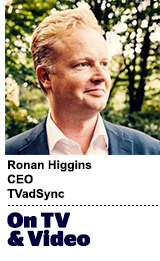
“On TV And Video” is a column exploring opportunities and challenges in advanced TV and video.
Today’s column is written by Ronan Higgins, CEO at TVadSync.
Vizio, Samsung and LG make up 70% of the smart TV market, with many of the other manufacturers trailing in the single digits. It’s a new tri-opoly for brands to contend with as they try to reach their customers through ever more complicated media channels.
All three of these giants understand modern economics. They will make more money from consumer data than from actual TV set sales. And each one has gone about creating a data business in a different way, from reselling to creating the first smart TV walled garden.
But smart TV manufacturers have a problem. Without working together, they’ll never hit the scale that brands need to truly embrace targeted advertising driven by automatic content recognition (ACR). And because of this, the walled garden model that brands are used to on the internet will never appear on ACR.
70 million is the magic number
There are about 130 million households in the United States. To reach a majority, brands often use 70 million as a rule of thumb. That’s why Cadent got a lot of high-fives when it was finally able to stitch together enough households to deliver an addressable TV product that would actually scale to this number.
EMarketer estimates there are 88.7 million connected TV households in the United States, or 71.6% of all households. However, each manufacturer only has a minority stake in that total. Samsung, the leader of the bunch, only offers reach of about a quarter of that, or 22 million households.
Even if every household in the country installed smart TVs and allowed data access, no single player would be able to get to 70 million households. That poses a problem for advertisers, who have been slow to move linear dollars into ACR because they crave reach.
Different from other walled gardens
When people talk about the walled gardens such as Facebook, Google and Amazon – or even Netflix and Hulu – they’re assuming near total market penetration. Anyone with an internet connection can download these apps and become part of the walled garden experience. And one person most likely has a login to all of these apps on their phone and even on their TV.
Samsung and the other TV manufacturers are playing a different game. As a piece of hardware, they aren’t going to be able to reach as many people as easily. People only buy one or two TVs. If they pick Samsung, Vizio is out of luck.
Even though they’re smart enough to be in the data game, they can’t get the same big picture or big reach as the walled gardens before them.
Not an MVPD, either
Some industry experts compare the smart TV manufacturers to MVPDs like Verizon, AT&T or Comcast. These legacy internet companies have pipes into a subset of US households, which limits their reach. After years of trying to intercept the advertising market and getting backhanded, they finally got permission from the US House of Representatives last year to resell data. But they’re still playing data catch-up.
By contrast, the smart TV companies have a data-first strategy. They’re much more proactive about getting user permission and creating products for sale. And therein lies the rub: They’re all going to hit up against their scale problem unless they work together.
Can Samsung play nice?
Samsung is the obvious outlier. While the other TV companies have licensed their data, Samsung has retreated inward. It not only sells its own data, it even serves ACR-targeted ads on its own DSP.
While everyone else in our market works to stitch together 70 million households, what will Samsung do? It can’t waste its market leadership, and so it will likely be persuaded to knock down some of the walls of its garden.
Creating the next GRP
ACR data is unique in that it allows brands to follow consumers from linear to digital and back again. As market demand grows, agencies, in particular, will feel the pressure to assemble a scaled audience for their advertisers.
Right now, with the major manufacturers working in their own lanes, the middlemen do the work to assimilate the data to create parity. From differences in measurement of video and audio to differences in content timing and engagement metrics, these companies haven’t really thought twice about what it would mean to create an aggregated audience together.
ACR data will soon take over TV. And like Nielsen’s GRP, a common currency will attract and retain big brands that need a universal metric for assessing audiences. The sooner the smart TV companies understand their position, the sooner they can agree on how to stitch their audiences together to get the attention of the brands still planning in GRPs.
Follow TVadSync (@TVadSync) and AdExchanger (@adexchanger) on Twitter.
This post was syndicated from Ad Exchanger.


More Stories
oOh!media backs YouthLine ‘Walk the Talk’ fundraiser
Air New Zealand wins March Kantar Ad Impact Award
Tegel gets heads bobbing with dentsu Aotearoa